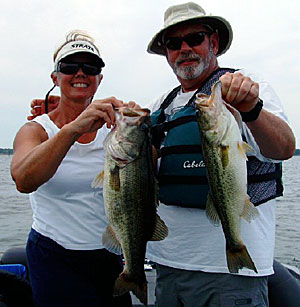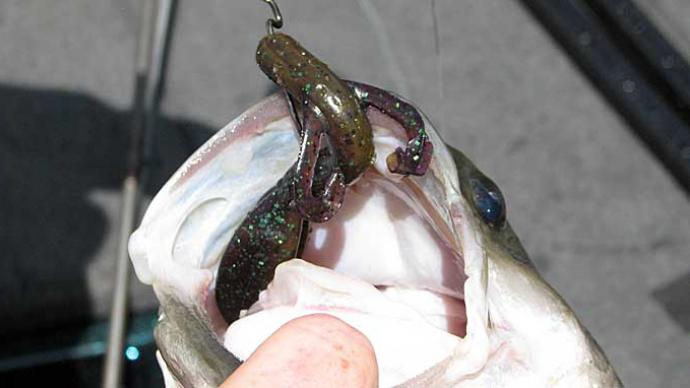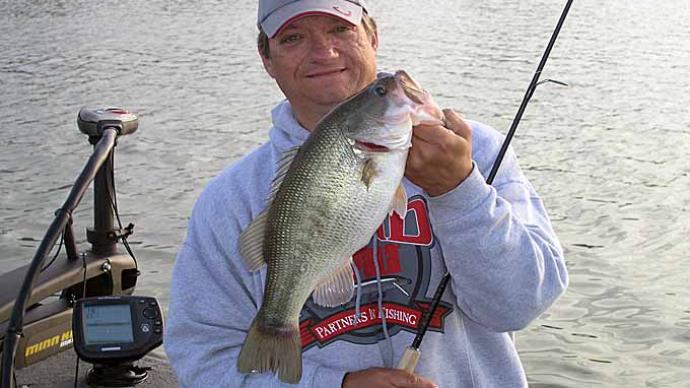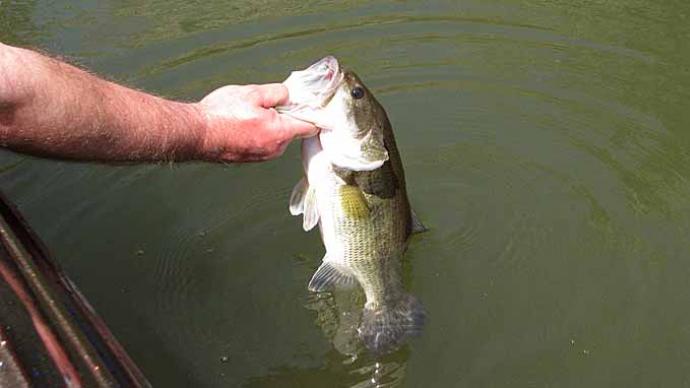
One of the first moves that boxers learn is the "one-two combo." The sequence of a left jab followed by a right cross is a basic fundamental for any prizefighter. Similarly, bass fishermen can quickly find and catch bass on Lake Fork in the fall using a simple horizontal and vertical presentation combo. Cover a lot of water with fast-moving, horizontally swimming baits like topwaters, spinnerbaits, and crankbaits. Once you get a few bites in an area, slow down and thoroughly fish the area with vertically falling lures like jigs and worms, and you'll often strike the mother lode.
In the fall, bass are on the chase following shad and can be located from the main lake to the very backs of creeks. Often, this location changes daily. Some days they'll be on the deeper cover, while other days, they'll be right up on the bank. Points, creek channels, and ledges can all be big producers in the fall, but often the bass will be roaming over expansive flats. Fishing methodically with a worm would take hours to locate the fish, so I work fast from the mouth of creeks to the very back until I find them, then I slow down and try to catch every one of them in the area.
Start by covering water fast with moving baits, like spinnerbaits, topwaters, and crankbaits. In the fall, use shad color schemes, primarily whites and chromes, and work these baits fast with erratic stop and go retrieves to trigger strikes from active fish. Since bass tend to key on the smaller young-of-the-year shad, I typically downsize my baits to replicate the forage. Spinnerbaits are a natural anytime bass key on shad, so 1/4 and 3/8 ounce Redemption spinnerbaits with white or chartreuse and white skirts and tandem silver willow leaf blades work well for me. Some days, 3/8th ounce white chatterbaits with a 3 1/2-inch Live Magic Shad trailer will produce better than a spinnerbait, especially for bigger fish.
Early and late, topwaters are hard to beat and fun to fish. I prefer small poppers on calm days, while the walking action of Sammy-type baits works better when there is more chop. My favorite bait is the Lucky Craft Gunfish 95. This bait doubles as a popper with a stop-and-go retrieve, or you can walk the dog with it. Try a variety of retrieves with the Gunfish and let the fish tell you how they want it.
Long casts spook less fish and also allow you to cover more water, but that can sometimes be hard with lighter topwater baits. I rig these on the Dobyns 685C rod with 17- to 21lb mono line. I can whip even the smallest poppers a mile.
Finally, my favorite search baits are shallow to medium running crankbaits, especially if there is wood, rock, or weed cover. I'll rig up a variety of cranks on fiberglass Dobyns 704 and 705 CB Glass rods, with 12- to 20lb Yo-Zuri line. I can cover water from one foot to the deep weed edge in twelve feet with various cranks and line sizes. Like Lucky Craft's RC 1.5 or the BDS 0 & 1, little square billed cranks are my favorites and work great in about four feet or less. I'll also try medium runners like the Skeet Mini MR and the Flat CB MR to probe the deep weed edge. Of course, don't forget the LV 100 and other lipless crankbaits if the fish are chasing over the tops of grass beds. Remember, with all of the cranks, that erratic action triggers strikes, so snap these baits free of grass, run them into rocks and wood, and momentarily pause during the retrieve, or pass up a lot of fish.

Finding fish is the hard part. Once a school is located with moving baits and the action slows, switch to soft plastics, and you'll likely catch more fish from the same area, possibly a lot more. My favorite soft plastic rigs for the fall are wacky-rigs and weightless soft plastic jerkbaits.
For the wacky rig, I use Hyper Finesse Worms and Whack'n Worms in shades of watermelon on sunny days and June bug or green pumpkin-colored ones on cloudy days, rigged on a 12lb line. The segmented tails on these baits make them quiver with every twitch of the rod. I rig up a Zig Zag on my wacky rig for bigger fish, and this larger bait will entice some big bass in the fall.
Another technique that excels is soft plastic jerkbaits like Magic Shads and Live Magic Shads, rigged weightless Texas-style. Some days the bass will chase these as they are steadily twitched over the grass, while other times, you'll do best by twitching your bait a couple of times and then letting it fall to the bottom.
Long casts are essential with these baits, so I use a 7-foot t3-inch Dobyns 734C to launch them and still have enough backbone to set the hook. Finally, for lunker bass during the fall, pitch the new MPack jig from Lake Fork Trophy Lures (with its beefy hook and sleek head) to the heaviest cover you can find in the areas you've already caught fish. I like black/blue-colored jigs on cloudy days and watermelon jigs on sunny days, trimmed with a matching Lake Fork Craw trailer, rigged on a tough 25lb line.
Try the horizontal-vertical combo to land a haymaker on the bass this fall, and you might become the bass heavyweight champ.




